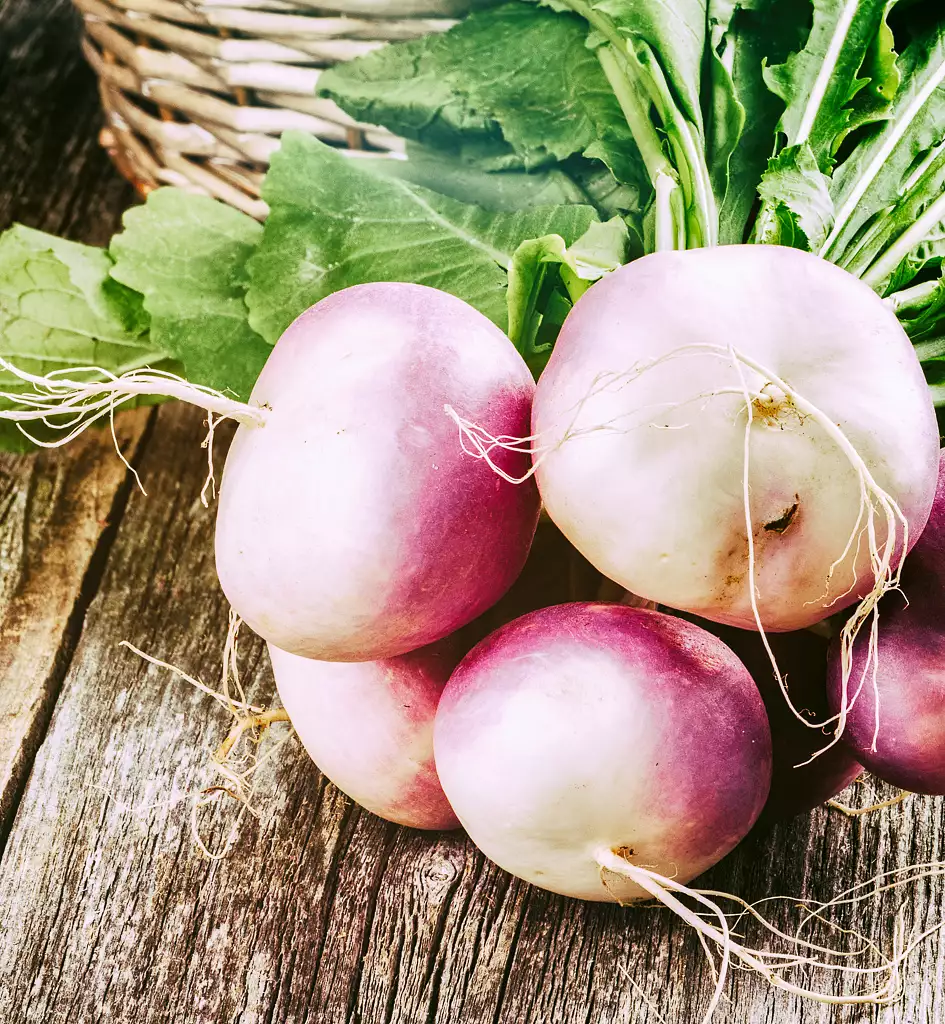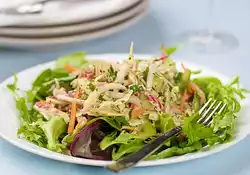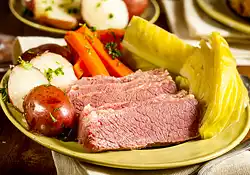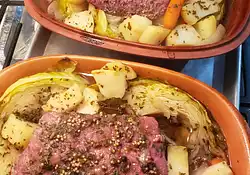Turnip
About the ingredient turnip. Including 201 recipes with turnip, nutrition data, and where to find it.

Contents
What is turnip?
The turnip's root is high only in vitamin C. The green leaves of the turnip top ("turnip greens") are a good source of vitamin A, folate, vitamin C, vitamin K and calcium. Turnip greens are high in lutein (8.5 mg / 100g).
The most common type of turnip is mostly white-skinned apart from the upper 1–6 centimeters, which protrude above the ground and are purple, red, or greenish wherever sunlight has fallen. This above-ground part develops from stem tissue, but is fused with the root. The interior flesh is entirely white. The entire root is roughly conical, but can be occasionally tomato-shaped, about 5–20 centimeters in diameter, and lacks side roots.
Turnip leaves are sometimes eaten as "turnip greens" ("turnip tops" in the UK), and they resemble mustard greens in flavor. Turnip greens are a common side dish in southeastern US cooking, primarily during late fall and winter.
Nutrition
Nutrition Facts
Serving Size 1 cup, cubes (156g)Where found
Turnip is usually found in the produce section or aisle of the grocery store or supermarket.
Food group
Turnip is a member of the Vegetables and Vegetable Products US Department of Agriculture nutritional food group.
How much does turnip weigh?
| Amount | Weight |
|---|---|
| 1 cup, cubes | 156 grams |
| 1 cup, mashed | 230 grams |
Related
Vegetables and Vegetable Products
| In Chinese: | 芜菁 | |
| British (UK) term: | ||
| en français: | navets | |
| en español: | nabos |
Recipes using turnip
There are 201 recipes that contain this ingredient.

Mixed Vegetable Salad with Maple, Soy Sauce & Mustard Vinaigrette
Different kinds of fresh vegetables are tossed with this flavourful vinaigrette, it goes well with any kind of main dish, or even good on its own!

Super-Moist Roast Turkey
This tender turkey is perfect for Thanksgiving. Especially if you don't want any leftovers!

Corned Beef & Cabbage
Authentic homemade Irish Corned Beef and Cabbage with parsnips, carrots and potatoes.

New England Boiled Dinner (Clay Pot)
This hearty and healthy New England Boiled Dinner is a classic dish that is perfect for feeding the whole family. Made in a clay pot, this one-pot meal is full of flavor and nutrition. The dish includes a variety of vegetables and protein, such as corned beef, cabbage, carrots, potatoes, and onions, all cooked together to create a delicious and satisfying meal. This recipe is perfect for busy weeknights or lazy Sundays, and is sure to become a family favorite.New England Boiled Dinner (Clay Pot) Classic boiled dinner is full of falvor and nutrition you need, and one pot tasty food that feeds the whole family!

Au Gratin Turnips & Potatoes
A simple and very economical side dish. Turnips and potatoes are roasted and then flavored with cheese and milk to create a simple creamy sauce.

Best Vegetable Burgers
A selection of root vegetables and herbs gives these veggie burgers excellent flavor and bits of hazelnuts and oats helps provide good texture.

Lemony Glazed Turnips & Carrots
Turnips and carrots are cooked in the pan and glazed with lemon, thyme and brown sugar. A quick and tasty side dish.

Hearty Stovetop Beef Stew
Chock full of beef and loads of veggies that suck up the flavor of the red wine, herbs and garlic. Make up a large batch on the weekend and freeze in individual portions in zipper bags for up to 3 months.

Sunday Vegetable Hash
A cost-effective veggie only hash that uses up basic pantry vegetables. Develops a nice crusty brown surface as it cooks.




















